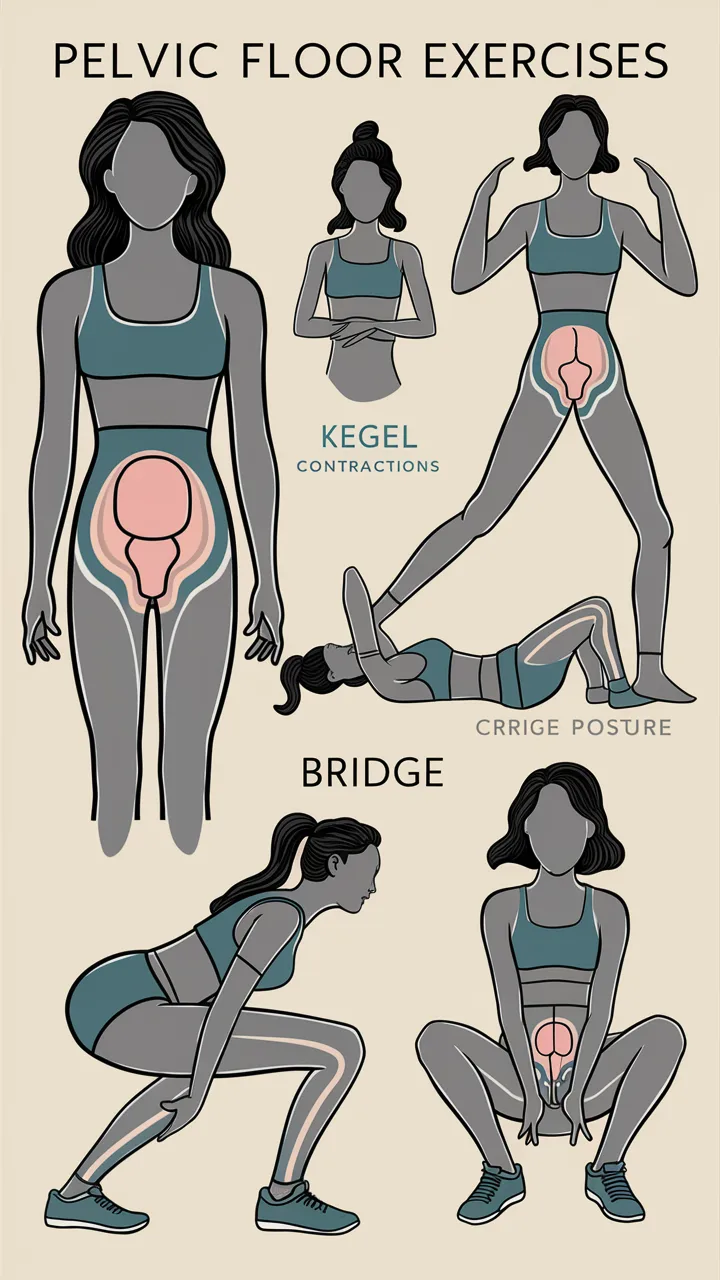Maintaining a healthy lifestyle throughout the vulnerable early stages of pregnancy is crucial, and starting early pregnancy exercises at home can greatly improve general well-being. These activities foster mental stability, which is necessary for the journey ahead, in addition to supporting physical health.
There are several safe and productive choices that expecting moms can make in the comfort of their own homes, ranging from strolling to mild yoga. A smoother transition into parenthood is facilitated by an understanding of the significance of maintaining an active lifestyle during pregnancy.
We’ll look at eight at-home early pregnancy exercises in this guide, which may be tailored to different fitness levels and tastes. Take advantage of this chance to put your health first and support the wonderful adventure of pregnancy by doing some simple yet effective workouts.
Walking:
Pregnant women can benefit greatly from walking, an aerobic low-impact activity, especially in the early stages of their pregnancy. It’s an easy, yet efficient, approach to keep moving without overtaxing your body.

Walking during pregnancy promotes good weight maintenance, enhances circulation, and reduces common pregnant discomforts like bloating and edema. Moreover, it helps to reduce stress and anxiety associated with pregnancy by releasing endorphins, which naturally elevate mood.
Tips for Walking Safely at Home or Outdoors
It doesn’t matter if you like to walk outside or inside; safety comes first. To avoid stumbling or falling, make sure your path is clear and unobstructed when you stroll about your house. To lower the risk of injury when walking outside, pick well-lit places and wear supportive, comfortable footwear.
Keep yourself hydrated, pay attention to your body’s signals, take pauses when necessary, and refrain from overexerting yourself. Walking, even for a brief stroll, should be a regular part of your routine as it can significantly improve your health and well-being throughout pregnancy.
Pelvic Floor Exercises:
Exercises for the pelvic floor, often known as Kegel exercises, are very important for expectant mothers, especially during the early stages of pregnancy. These exercises help avoid urine incontinence and prepare the body for childbirth by focusing on the muscles that support the uterus, bladder, and bowels.

By encouraging quicker healing and restoring muscular tone, strengthening the pelvic floor muscles can also help in the postpartum recovery process. Frequent pelvic floor exercises can enhance pelvic stability and lower the possibility of difficulties during childbirth.
Importance of Pelvic Floor Exercises during Pregnancy
Pelvic floor exercises are particularly vital during pregnancy due to the increased pressure on the pelvic region caused by the growing fetus. These exercises help maintain pelvic floor strength and integrity, which is essential for supporting the additional weight of the uterus and baby.
By incorporating pelvic floor exercises into your early pregnancy exercises at home routine, you can effectively address common issues such as urinary leakage and pelvic pain, while also preparing your body for the demands of childbirth.
Prenatal Yoga:
A safe and beneficial kind of exercise for pregnant mothers, even those who are just starting their pregnancy, is prenatal yoga. It incorporates breathing exercises, meditation, and physical postures to support general health throughout pregnancy.
Strength, balance, and flexibility are all enhanced by prenatal yoga, which is especially advantageous when the body adjusts to support the developing fetus. In addition, it offers a protective atmosphere where women can establish bonds with their fetuses and with their bodies.
To ensure pregnant women’s safety and comfort during the practice, prenatal yoga sessions frequently contain modifications catered to their specific needs.
Beginner-Friendly Prenatal Yoga Poses for Early Pregnancy
There are several advantages to including prenatal yoga in your at-home workout regimen during the first trimester of pregnancy. Easy positions like Cat-Cow, Modified Downward-Facing Dog, and Supported Warrior II ease tension and promote relaxation by strengthening and stretching the muscles.
Even in the early stages of pregnancy, these poses are appropriate for pregnant women since they emphasize gentle movements and correct alignment.
Expectant moms can improve their physical and mental health while preparing their bodies for the life-changing experience of pregnancy and childbirth by doing prenatal yoga at home.
Swimming or Water Aerobics:
For women who are pregnant or who are just starting their pregnancy and are looking for safe and efficient exercise, swimming and water aerobics are great options. Water is a great low-impact exercise choice since its buoyancy helps to support the weight of the expanding belly and lessens joint stress.
Water workouts reduce the chance of injury while enhancing muscular strength, flexibility, and cardiovascular health. Furthermore, the resistance of the water offers a mildly efficient means of maintaining general fitness levels and toning muscles throughout pregnancy.
Additionally, swimming and water aerobics provide a cool, fun method to stay hydrated and relieve common pregnant discomforts like back pain and edema.
Incorporating swimming or water aerobics into an early pregnancy exercises-at-home routine can be convenient and accessible with the availability of home pools or local aquatic centers. With proper guidance and precautions, expectant mothers can safely enjoy the benefits of aquatic exercise throughout their pregnancies.
Low-Impact Aerobics:
Low-impact aerobics is a fantastic exercise option for pregnant women, particularly those in the early stages of pregnancy, looking to maintain their fitness levels safely. Unlike high-impact activities, low-impact aerobics minimize stress on the joints while still providing an effective cardiovascular workout.
These exercises typically involve movements that keep one foot on the ground at all times, reducing the risk of strain or injury. Low-impact aerobics routines can include activities like walking, marching, step aerobics with a low platform, and dance-inspired movements.
Low-impact aerobics can be an easy and convenient addition to any at-home workout regimen for early pregnancy, requiring little in the way of space and equipment.
Expectant mothers can promote cardiovascular health, increase energy levels, and improve circulation by engaging in a low-impact aerobics practice designed just for them.
These workouts can also aid in controlling weight gain, easing discomforts associated with pregnancy, and fostering well-being during this period of profound change.
Strength Training with Bodyweight Exercises:
Pregnant women, particularly those in the early stages of pregnancy, can safely and effectively maintain their muscle tone and strength without the use of specialist equipment by engaging in strength training using bodyweight exercises.
The resistance of one’s own body is used in bodyweight workouts to increase strength and stamina. Pregnancy-safe bodyweight workouts include modified push-ups, lunges, squats, and pelvic tilts.
These workouts work the arms, legs, glutes, and core, among other muscle groups, to assist increase general fitness and get the body ready for the physical demands of pregnancy and labor.
Enhancing muscle tone, stabilizing the body, and improving posture are just a few advantages of including bodyweight exercises in an early pregnancy workout regimen at home.
Expectant moms can lessen their chance of experiencing musculoskeletal discomforts, like lower back pain, by doing these exercises on a regular basis and with good form.

Preserving muscular mass during pregnancy can also help improve general physical function and facilitate a more seamless recovery after giving birth.
Stretching and Relaxation Techniques:
Stretching and relaxation techniques are invaluable for pregnant women, particularly those in the early stages of pregnancy, seeking to alleviate tension, reduce stress, and promote overall well-being.
Gentle stretching exercises help to maintain flexibility, relieve muscle tightness, and improve circulation, which can be especially beneficial as the body undergoes changes during pregnancy.
Common stretches for pregnant women include hamstring stretches, calf stretches, hip flexor stretches, and chest stretches.
Expectant women can improve their body image and ease pregnancy-related discomforts by incorporating stretching and relaxation techniques into their at-home exercise regimen during the first trimester.
Furthermore, using relaxation methods like progressive muscle relaxation, deep breathing, and guided imagery might improve general mental well-being during pregnancy help lower anxiety, and improve sleep.
Pregnant women can develop a sense of calm and readiness for the trip ahead by making time at home to stretch and rest.
Safety Precautions and Tips:
Ensuring safety is paramount when engaging in early pregnancy exercises at home. Pregnant women should prioritize their well-being and take necessary precautions to minimize risks and optimize the benefits of exercise.
Firstly, it’s crucial to consult with a healthcare provider before starting any exercise routine, especially during pregnancy, to ensure it’s safe for both mother and baby. Additionally, listening to your body is key—stop exercising if you experience any discomfort, pain, dizziness, or shortness of breath.
When exercising at home, create a safe environment by wearing supportive footwear, using non-slip mats, and ensuring adequate hydration throughout the workout. Avoid exercises that involve lying flat on your back after the first trimester to prevent pressure on major blood vessels. Modify movements as needed to accommodate your changing body and avoid high-impact activities or contact sports that pose a risk of injury.
By following these safety precautions and tips, pregnant women can enjoy the benefits of exercise while minimizing potential risks, promoting a healthy pregnancy, and preparing for the journey of motherhood ahead.
Conclusion:
In conclusion, prioritizing early pregnancy exercises at home is a proactive step towards ensuring a healthy and fulfilling journey through pregnancy. By embracing safe and suitable exercises, expectant mothers can nurture their physical and emotional well-being, alleviate discomforts, and prepare their bodies for childbirth and beyond.
Remember, consulting with a healthcare provider and listening to your body is essential for a safe and enjoyable exercise routine during this transformative time. Make the commitment to yourself and your baby to stay active and empowered throughout your pregnancy journey.
FAQs:
Q: Are early pregnancy exercises at home safe for me and my baby?
A: Yes, when done correctly and with guidance from your healthcare provider, early pregnancy exercises at home are generally safe and beneficial for both you and your baby.
Q: What are the best exercises for early pregnancy at home?
A: Walking, prenatal yoga, swimming or water aerobics, low-impact aerobics, and strength training with bodyweight exercises are excellent options for early pregnancy exercises at home.
Q: How often should I exercise during early pregnancy?
A: Aim for at least 30 minutes of moderate-intensity exercise most days of the week. Listen to your body and adjust the frequency and intensity as needed.
Q: Can I start a new exercise routine if I wasn’t active before pregnancy?
A: It’s best to start slowly and gradually increase the intensity and duration of your workouts. Consult with your healthcare provider before beginning any new exercise regimen.
Q: Are there any exercises I should avoid during early pregnancy?
A: Avoid high-impact activities, exercises that involve lying flat on your back after the first trimester, and any movements that feel uncomfortable or cause pain. Always prioritize safety and listen to your body’s cues.

1 thought on “8 Early Pregnancy Exercises at Home”